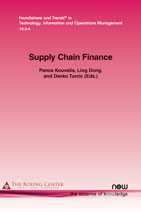On the Cost of Capital in Inventory Models: The Case of Deterministic Demand
By Alejandro Serrano, IESE Business School and Zaragoza Logistics Center, Spain, aserrano@iese.edu
Abstract
In the operations management literature, the financial risk in an inventory model is usually assumed to be captured by the (constant) weighted average cost of capital (WACC) of the firm. This assumption is, at best, an approximation, since this cost depends on the risk of the cash flows, which, in turn, depends on the inventory policy. This paper explores what the right cost of capital should be in an inventory model with deterministic demand. We find that, in contrast to other existing models, risk is not in general a monotone function of inventory. Also, a rate close to the risk-free rate, which typically deviates significantly from the WACC, should be used to value inventory-related investments when the inventory cost function is dominated by holding cost for large order quantities, even if investments are subject to other sources of financial variability.
Supply Chain Finance
Supply Chain Finance focuses is on creating liquidity in the supply chain through various Buyer or Seller-led solutions with or without a facilitating technology. The role of supply chain finance (SCF) is to optimize both the availability and cost of capital within a given buyer-supplier supply chain. To add further value, information on the physical flow of goods can be monitored. The coupling of information enables lenders to mitigate financial risk within the supply chain. The mitigation of risk allows more capital to be raised, capital to be accessed sooner, or capital to be raised at lower rates. Supply chain participants reside in diverse economic environments, are of different sizes, face a variety of uncertainties, have different bargaining powers over its trading partners, and have different accessibilities to capital markets. Many forms of financing arrangements between buyers and suppliers have emerged intending to overcome challenges in their specific economic and business environments.
Part 1 examines Supplier Financing. The three papers included in this section discuss supplier based financing issues including: motivation and rationale for supplier based financing, the optimal mix of bank financing and supplier financing, and empirical study of the impact of trade credit on firm performance. Part 2 focuses on Buyer Financing including three papers included that discuss buyer based financing issues in supply chains including the rationales of different types of buyer based financing arrangements and their impacts on supply chain performance. Part 3 reviews Inventory Models and Financing Consideration and the two papers in this part of the book explore how to coordinate the management of the cash flow and inventory flow within an organization and the relationship between a firm’s inventory policy and its cost of capital. Part 4 examines Operational Investments and Financing Issues and includes four papers that address operational investments with explicit financing considerations.

Companion
Foundations and Trends® in Technology, Information and Operations Management, Volume 10, Issue 3-4 Special Issue: Supply Chain Finance
See the other articles that are also part of this special issue.